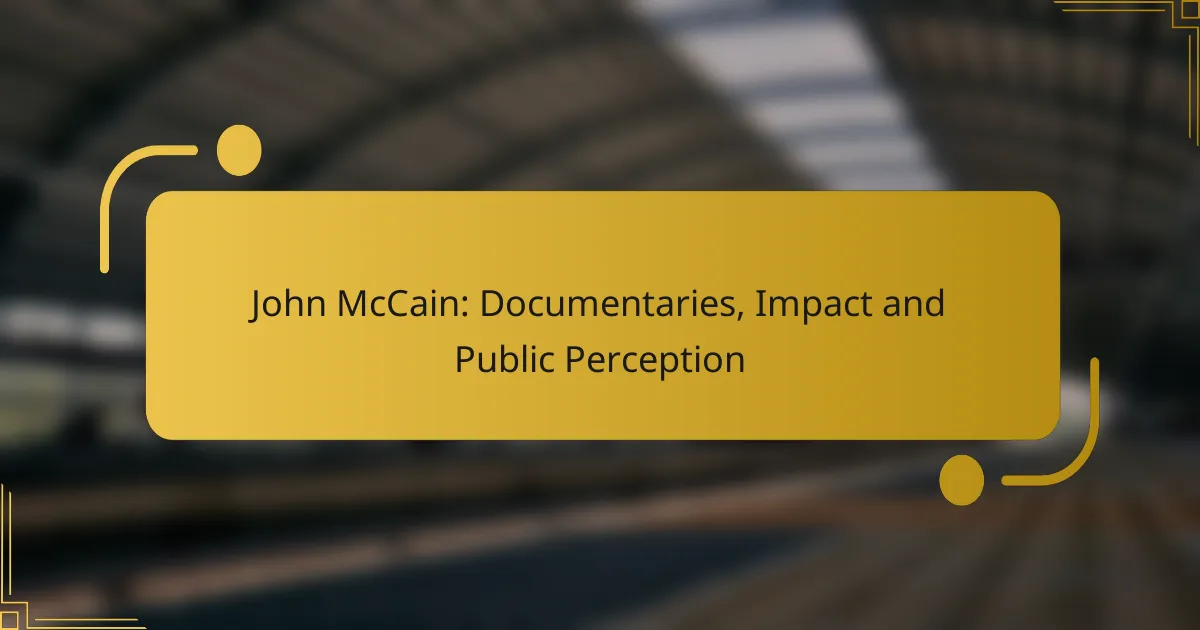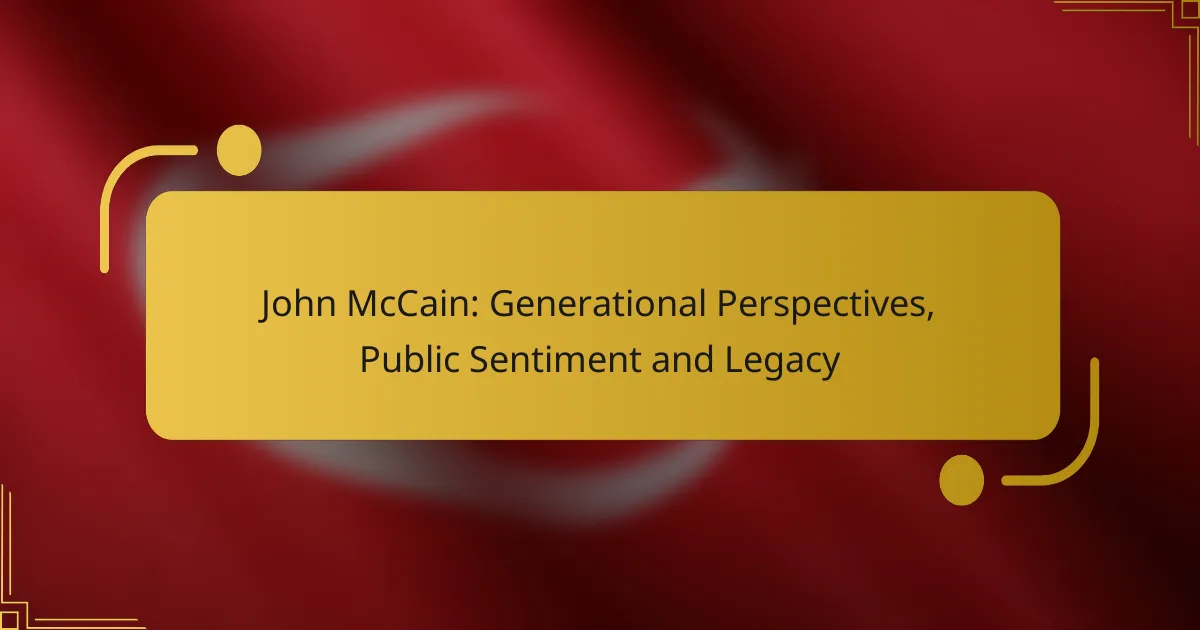John McCain’s memorial is notable for its emphasis on national significance and public engagement, showcasing his distinctive role in American politics. Unlike many other leaders, his memorial events fostered bipartisan respect and active public participation, highlighting the complexity of his legacy. Public perceptions of McCain reveal a mix of admiration for his principled leadership and criticism of his political choices, setting him apart from other political figures. Memorials dedicated to him, much like those for other prominent leaders, serve as lasting tributes to their contributions and influence in society.
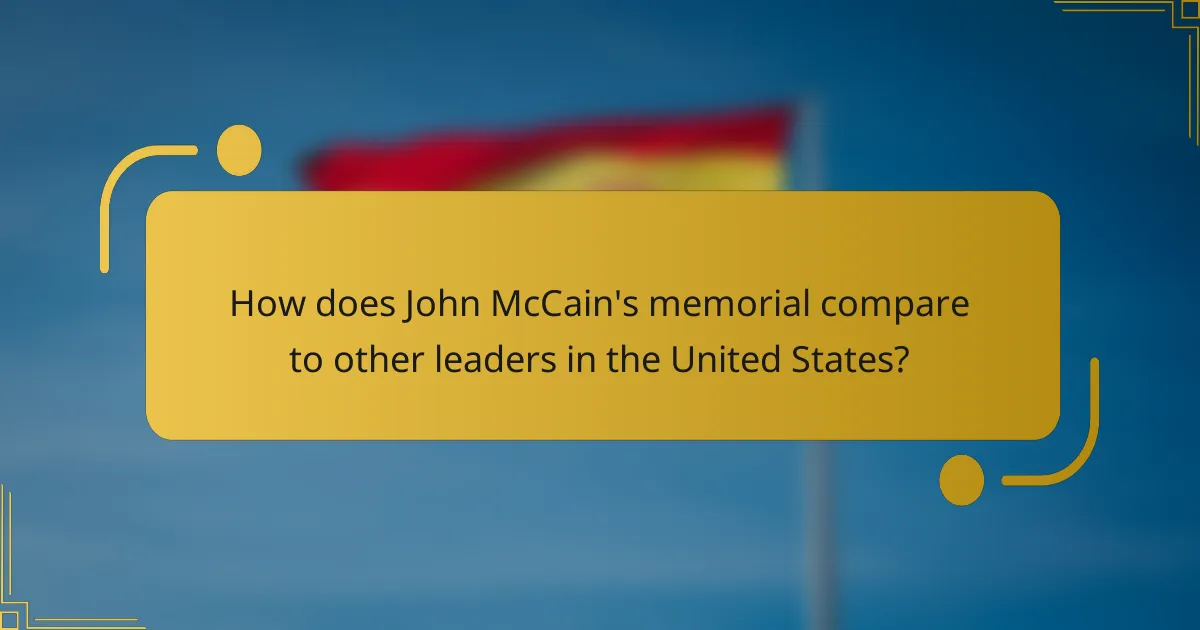
How does John McCain’s memorial compare to other leaders in the United States?
John McCain’s memorial stands out for its blend of national significance and public engagement, reflecting his unique role in American politics. Compared to other leaders, his memorial events emphasized bipartisan respect and widespread public participation.
National memorial significance
John McCain’s memorial resonated deeply within the national consciousness, symbolizing values such as service, sacrifice, and bipartisanship. His status as a war hero and long-serving senator contributed to a memorial that was not just a farewell but a celebration of American ideals.
In contrast, other leaders’ memorials, such as those for presidents or civil rights figures, often focus on specific historical contexts or achievements. McCain’s memorial was distinctive in its appeal across party lines, highlighting a collective respect for his contributions to the nation.
Public attendance and participation
The public response to McCain’s memorial was significant, with thousands attending services in Washington, D.C., and Arizona. This turnout reflected a broad spectrum of Americans who admired his dedication and service, showcasing a rare moment of unity in a polarized political landscape.
Other leaders, such as Ronald Reagan or Martin Luther King Jr., also drew large crowds, but McCain’s memorial was marked by a unique blend of political figures from both parties, emphasizing his legacy as a unifying figure. This participation included not only politicians but also everyday citizens, illustrating the widespread impact he had on American life.
Media coverage analysis
Media coverage of John McCain’s memorial was extensive, with major networks providing live broadcasts and in-depth analyses. Coverage highlighted his military service, political career, and personal anecdotes from friends and colleagues, creating a comprehensive narrative of his life.
In comparison, memorials for other leaders often focus on specific achievements or historical significance, sometimes lacking the personal touch that characterized McCain’s coverage. The media’s portrayal of McCain emphasized his role as a bridge-builder, which resonated with audiences and shaped public perception during the memorial events.

What are the public perceptions of John McCain compared to other leaders?
Public perceptions of John McCain often highlight his reputation as a principled leader, contrasting with varying views on other political figures. While some admire his bipartisan approach and military service, others critique his political decisions, reflecting a complex legacy in American politics.
Approval ratings over time
John McCain’s approval ratings fluctuated significantly throughout his career, particularly during his presidential campaign in 2008, where he experienced a surge in support. Generally, his ratings tended to be higher among independent voters compared to partisan groups, reflecting his appeal across the political spectrum. In contrast, other leaders often see more stable or polarized approval ratings, depending on their party affiliation and policies.
Legacy and impact on American politics
McCain’s legacy is marked by his commitment to bipartisanship and national service, influencing how future leaders approach collaboration across party lines. His stance on issues like immigration reform and campaign finance has left a lasting impact, prompting discussions on the importance of integrity in politics. Compared to other leaders, McCain’s willingness to challenge his own party on critical issues has set a precedent for political courage, though it has also led to mixed perceptions among constituents.

What memorials exist for John McCain and other leaders?
John McCain is commemorated through various memorials that reflect his legacy, similar to other prominent leaders. These memorials serve as tributes to their contributions and influence, often located in significant places that resonate with their life stories.
Locations of memorials
John McCain’s memorials are primarily located in Arizona and Washington, D.C. The most notable is the John McCain Memorial in the U.S. Capitol, which honors his service and dedication. Other leaders, such as Martin Luther King Jr. and George Washington, have memorials situated in prominent national parks and city centers, making them accessible to the public.
In addition to national memorials, local tributes can be found in various states, often in parks or civic centers named after these leaders. For instance, the Martin Luther King Jr. Memorial is located on the National Mall in Washington, D.C., while the George Washington Memorial Parkway runs alongside significant sites related to Washington’s life.
Design and symbolism of memorials
The design of John McCain’s memorials often incorporates elements that symbolize his military service and political career, such as eagles and flags. These designs aim to evoke respect and admiration, reflecting his commitment to the nation. Similarly, memorials for other leaders, like the Lincoln Memorial, utilize neoclassical architecture to convey strength and permanence.
Symbolism plays a crucial role in memorials, with many incorporating quotes or images that represent the leader’s values and achievements. For example, the Martin Luther King Jr. Memorial features a stone statue of King, surrounded by inscriptions of his famous quotes, emphasizing his message of equality and justice. Such designs not only honor the individual but also inspire future generations to uphold their ideals.

How do memorials influence public perception of leaders?
Memorials play a significant role in shaping public perception of leaders by commemorating their contributions and values. They serve as focal points for collective memory, influencing how society remembers and interprets a leader’s legacy.
Emotional impact on the public
Memorials evoke strong emotional responses, often fostering a sense of national pride or collective mourning. For instance, the memorials dedicated to John McCain resonate deeply with many Americans, reflecting values such as service and sacrifice.
These emotional connections can enhance public support for a leader’s policies or actions, as memorials often highlight their most admirable qualities. This emotional impact can lead to a more favorable public image, especially during times of national reflection.
Long-term effects on historical narratives
Memorials contribute to the long-term shaping of historical narratives by framing the context in which leaders are remembered. They often emphasize particular aspects of a leader’s life, which can overshadow other elements that may be less favorable.
For example, memorials can lead to a simplified version of a leader’s legacy, focusing on heroic deeds while downplaying controversies. This selective memory can influence future generations’ understanding of history and the lessons drawn from it.
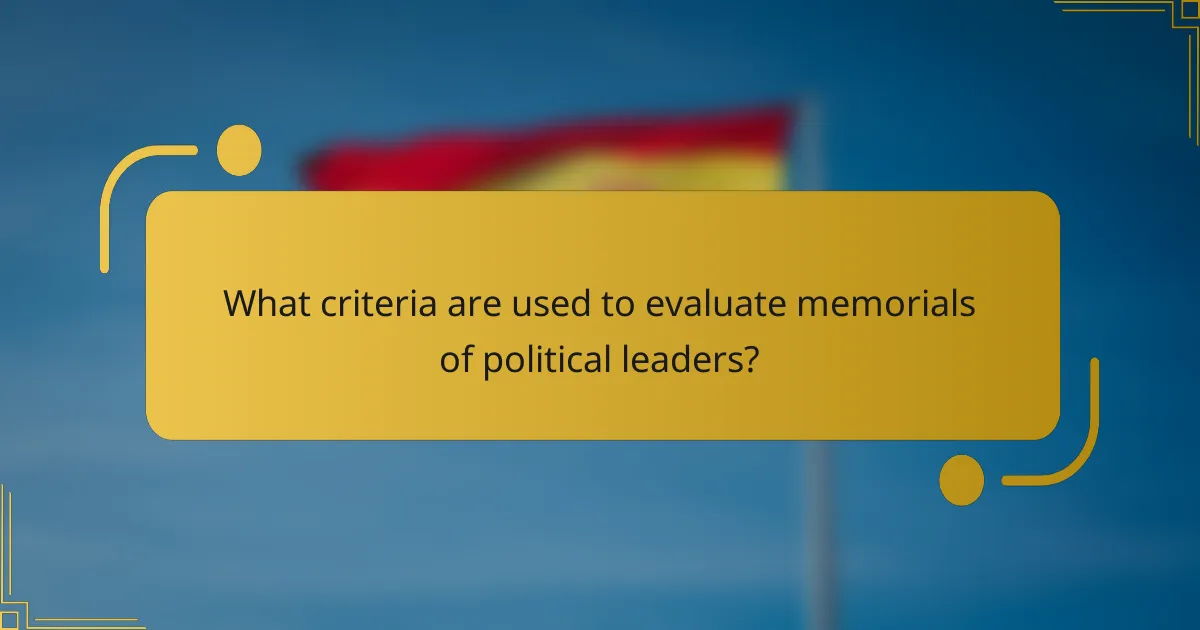
What criteria are used to evaluate memorials of political leaders?
Memorials of political leaders are evaluated based on design elements, public accessibility, and engagement. These criteria help determine how effectively a memorial honors the leader’s legacy and resonates with the public.
Design elements and artistic representation
The design elements of a memorial include its architectural style, materials used, and artistic representation. Effective memorials often reflect the leader’s values and contributions through symbolism and aesthetics, creating a meaningful connection for visitors.
For example, a memorial might incorporate local materials or historical references to enhance its significance. The use of space, such as open areas for reflection or interactive features, can also impact how the memorial is perceived and experienced.
Public accessibility and engagement
Public accessibility refers to how easily individuals can visit and interact with a memorial. Factors such as location, transportation options, and physical accessibility for those with disabilities play a crucial role in determining a memorial’s reach.
Engagement can be fostered through educational programs, guided tours, and community events that invite public participation. Memorials that actively involve the community often create a stronger emotional connection and promote ongoing dialogue about the leader’s impact.
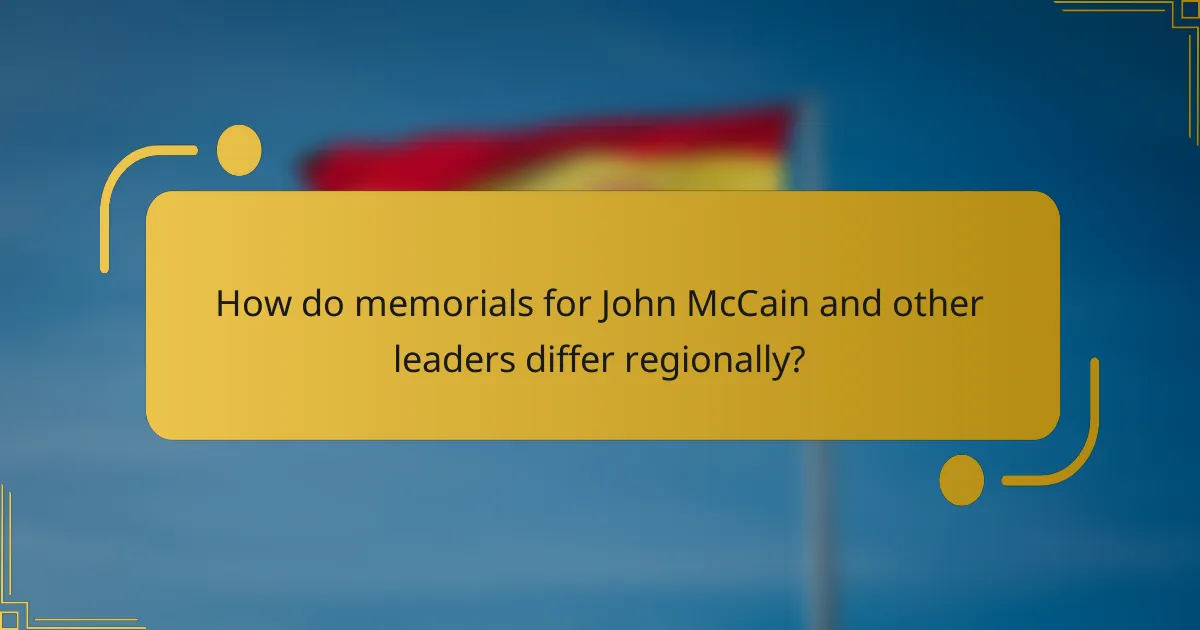
How do memorials for John McCain and other leaders differ regionally?
Memorials for John McCain and other leaders exhibit significant regional differences in style, design, and community involvement. These variations reflect local cultural values, historical contexts, and public sentiments towards the leaders being memorialized.
Regional variations in memorial styles
Memorial styles can vary widely across regions, influenced by local traditions and artistic preferences. For example, in the United States, McCain’s memorials often feature grand structures or public ceremonies, while in Europe, memorials may lean towards understated plaques or gardens that encourage reflection.
In some areas, memorials may incorporate interactive elements, such as digital displays or community art projects, while others may focus on traditional stone monuments. This diversity allows communities to express their unique relationship with the leader being honored.
Community involvement in memorial creation
Community involvement plays a crucial role in the creation of memorials, with varying degrees of public participation depending on the region. In many U.S. cities, local residents are often invited to contribute ideas or designs, fostering a sense of ownership and connection to the memorial.
Conversely, in some regions, memorials may be designed primarily by government officials or artists without extensive public input. This can lead to a disconnect between the memorial and the community’s sentiments, highlighting the importance of inclusive processes in memorial creation.

What emerging trends are shaping the future of political memorials?
Emerging trends in political memorials reflect a shift towards more interactive and inclusive experiences. As society evolves, so do the methods of honoring political figures, with a focus on digital engagement and changing perceptions of legacy.
Digital memorials and virtual experiences
Digital memorials are becoming increasingly popular as they allow for broader access and engagement. Virtual experiences can include online tributes, interactive websites, and augmented reality installations that bring a leader’s legacy to life in innovative ways.
These digital platforms often encourage public participation, allowing individuals to share their stories or memories, which can foster a sense of community. For instance, a virtual memorial for a political leader might feature a timeline of their achievements alongside user-generated content, creating a dynamic and evolving tribute.
Changing public attitudes towards political legacies
Public attitudes towards political legacies are shifting, with a growing emphasis on transparency and accountability. Many people now seek a more nuanced understanding of political figures, recognizing both their contributions and shortcomings.
This change is reflected in how memorials are designed, often incorporating diverse perspectives and encouraging critical discussions. For example, memorials may include elements that address controversial aspects of a leader’s career, inviting visitors to engage with the complexities of their legacy rather than presenting a one-dimensional view.

